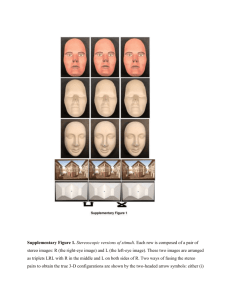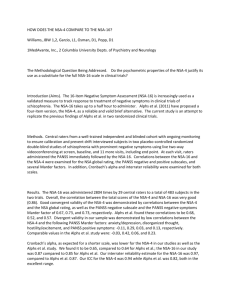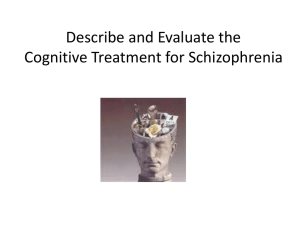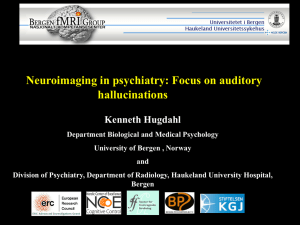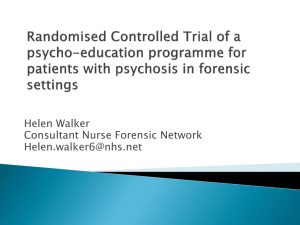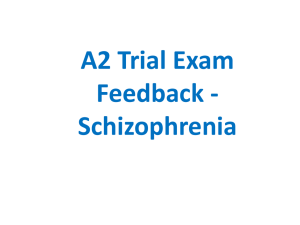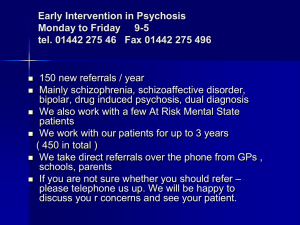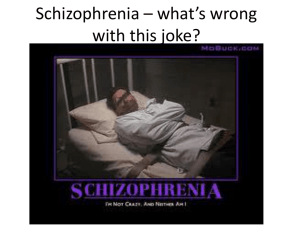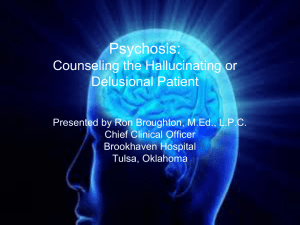Sunderland and Gateshead/South Tyneside EIP
advertisement
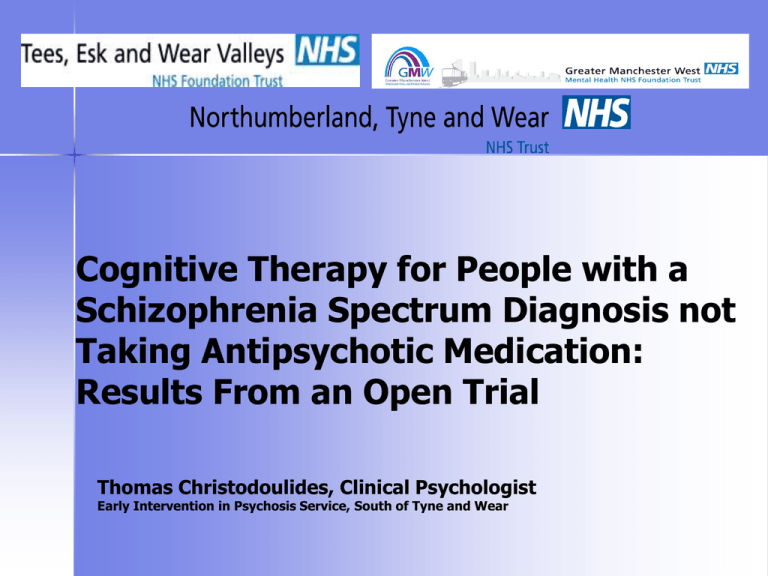
Cognitive Therapy for People with a Schizophrenia Spectrum Diagnosis not Taking Antipsychotic Medication: Results From an Open Trial Thomas Christodoulides, Clinical Psychologist Early Intervention in Psychosis Service, South of Tyne and Wear Acknowledgments Tony Morrison Douglas Turkington Melissa Wardle, Helen Spencer, Laura Drage, Paul French Rory Byrne Robert Dudley, Paul Hutton, Victoria Lumley, Alison Brabban, Pauline Callcott, Nicola Chapman, Sara Tai Background NICE (2009): Antipsychotic medication is recommended as first line of treatment But many service users choose not to take, or discontinue pharmacological treatment: – Lieberman et al (2005) 74% discontinued their medication within 18 months – Lacro et al (2002) Estimated rate of medication non-compliance in Schizophrenia: 40%-50% Reasons for discontinuing Moncrieff et al (2009): service users opposed to taking antipsychotic medication. Why? Lack of insight Stigma Concerns about side effects – – – – – weight gain Extra pyramidal Cardiovascular problems (Tandon et al, 2008) Increased risk of sudden cardiac death (Ray et al, 2009) Cerebral abnormalities (Ho et al, 2011) Response to medication Leucht et al (2009): – meta analysis – atypicals > placebos on the PANSS by only 10 pts (about 5%) Choice and Empowerment Owens et al (2008) – many inpatients retain treatment decision making capacity Warner et al (2006) – Literature review on choice and decision making – Service users want to be offered more than just medication NICE guidelines for Schizophrenia (2009) – Recommended treatment choice for the individual – All patients with Schizophrenia should have access to CBT and family interventions. CBT with antipsychotic medication Pilling et al (2002); Wykes, Steel & Tarrier (2008) – Meta analyses – CBT effective in combination with antipsychotic medication CBT in the absence of antipsychotic medication? Morrison (1994) - Single case: CBT achieved significant reduction in auditory hallucinations. Morrison (2001) - Case series: Reported significant reduction in conviction, frequency, and distress associated with auditory hallucinations. CBT in the absence of antipsychotic medication? Christodoulides et al (2008) Wellcome and Insight trials – Small number reported as antipsychotic medication free – Showed significant improvement on a wide range of psychometric assessment measures – Case series: Reduction in positive and negative symptoms of schizophrenia. Design Aim – To assess the feasibility and effectiveness of CBT for patients not taking antipsychotics Dual Site – North East (Professor Douglas Turkington) – Manchester (Professor Tony Morrison) Experienced therapists offering 9 months CBT 25 sessions. Manualized therapy – Turkington et al (2009); Morrison et al (2008) Recruiting from EIP, CMHT, CAMHS 20 participants Inclusion Criteria: ICD-10 diagnosis of schizophrenia, schizo-affective disorder or delusional disorder Or 4+ score on the PANSS on hallucinations or delusions, or 5 on conceptual disorganization, grandiosity, or suspiciousness Age 16-65 years Exclusion Criteria: Organic brain disease including dementia, epileptic psychosis, head injury (impaired cognitive functioning and with subsequent inability to engage in CBT) Use of antipsychotic medication in previous 6 months. Primary diagnosis of drug or alcohol misuse Impaired intellect severe enough to interfere with ratings Receiving acute psychiatric inpatient care at baseline, (patients must be stable enough to engage in CBT, and to justify continued absence of antipsychotic medication). Previous manualised CBT for psychosis and/or previous manualised CBT for anxiety/depression within the last 2 years (those previously exposed to CBT may be habituated to the model). Diagnosis All diagnosis established using – ICD-10 – Case notes – Review by a consultant psychiatrist – Schizophrenia (n =15) – Schizo-affective disorder (n = 4) – Delusional disorder (n = 1) Outcome measures PANSS – 30 item (0-7) – semi-structured interview of +ve and –ve symptoms and psychopathology PSYRATS – clinician administered 11 item (0-4) questionnaire of hallucinations and delusions Clinically significant change on PANSS – >50%, >25%, <25% Outcome measures PRP – user defined measure of recovery – 22 item questionnaire PSP – Personal and Social Performance Scale – 100 point single item rating scale Socially useful activities Personal and social relationships Self care Disturbing and aggressive behaviour Psychometric Assessment Schedule: Therapy Booster sessions >4 sessions (6 months post therapy) Therapy (9 months >25 sessions) Baseline 3 months Measures Jan Feb 6 months Measures Mar Apr May Jun 9 months Measures Jul Aug Sep 15 months (Follow-up: 6 months post therapy) Measures Oct Nov Dec Measures Jan Feb Mar Apr Intervention Maximum 26 sessions 9 months Beckian CBT Manual based – Morrison et al (2004b) – Kingdon & Turkington (2005) Model – Morrison (2001b) – Normalize and de-catastrophize – generate and explore alternatives Results 1 Variable Pretreatment Mean (S.D.) Posttreatment mean (S.D.) t/Wa P d 95% CI PANSS total 69.55 (11.99) 59.20 (19.52) 3.66 0.0002 0.85 0.321.35 PANSS Positive 18.75 (4.74) 14.65 (7.37) 2.99 0.0003 0.87 0.451.53 PANSS Negative 14.60 (5.06) 12.40 (5.58) 3.33 0.001 1.00 0.451.54 Results 1 Variable Pretreatment Mean (S.D.) Posttreatment mean (S.D.) t/Wa P d 95% CI PANSS total 69.55 (11.99) 59.20 (19.52) 3.66 0.0002 0.85 0.321.35 PANSS Positive 18.75 (4.74) 14.65 (7.37) 2.99 0.0003 0.87 0.451.53 PANSS Negative 14.60 (5.06) 12.40 (5.58) 3.33 0.001 1.00 0.451.54 Results 1 Variable Pretreatment Mean (S.D.) Posttreatment mean (S.D.) t/Wa P d 95% CI PANSS total 69.55 (11.99) 59.20 (19.52) 3.66 0.0002 0.85 0.321.35 PANSS Positive 18.75 (4.74) 14.65 (7.37) 2.99 0.0003 0.87 0.451.53 PANSS Negative 14.60 (5.06) 12.40 (5.58) 3.33 0.001 1.00 0.451.54 Results 1 Variable Pretreatment Mean (S.D.) Posttreatment mean (S.D.) t/Wa P d 95% CI PANSS total 69.55 (11.99) 59.20 (19.52) 3.66 0.000 2 0.85 0.321.35 PANSS Positive 18.75 (4.74) 14.65 (7.37) 2.99 0.000 3 0.87 0.451.53 PANSS Negative 14.60 (5.06) 12.40 (5.58) 3.33 0.001 1.00 0.451.54 Results 2 Variable Pretreatment Mean (S.D.) Follow up (S.D.) t/Wa P d 95% CI PANSS total 69.55 (11.99) 54.30 (17.23) 5.63 0.000 1.26 0.661.84 PANSS Positive 18.75 (4.74) 13.35 (6.11) 3.31 0.0001 1.08 0.511.62 PANSS Negative 14.60 (5.06) 12.15 (5.41) 2.80 0.0005 0.79 0.271.28 Results 2 Variable Pretreatment Mean (S.D.) Follow up (S.D.) t/Wa P d 95% CI PANSS total 69.55 (11.99) 54.30 (17.23) 5.63 0.000 1.26 0.661.84 PANSS Positive 18.75 (4.74) 13.35 (6.11) 3.31 0.0001 1.08 0.511.62 PANSS Negative 14.60 (5.06) 12.15 (5.41) 2.80 0.0005 0.79 0.271.28 Results 2 Variable Pretreatment Mean (S.D.) Follow up (S.D.) t/Wa P d 95% CI PANSS total 69.55 (11.99) 54.30 (17.23) 5.63 0.000 1.26 0.661.84 PANSS Positive 18.75 (4.74) 13.35 (6.11) 3.31 0.0001 1.08 0.511.62 PANSS Negative 14.60 (5.06) 12.15 (5.41) 2.80 0.0005 0.79 0.271.28 Results 2 Variable Pretreatment Mean (S.D.) Follow up (S.D.) t/Wa P d 95% CI PANSS total 69.55 (11.99) 54.30 (17.23) 5.63 0.000 1.26 0.661.84 PANSS Positive 18.75 (4.74) 13.35 (6.11) 3.31 0.000 1 1.08 0.511.62 PANSS Negative 14.60 (5.06) 12.15 (5.41) 2.80 0.000 5 0.79 0.271.28 Results 3 Variable Pretreatment Mean (S.D.) Posttreatment Mean (S.D.) t/Wa P d 95% CI PSYRATS Hallucinations 19.35 (15.03) 10.80 (13.34) 2.17 0.03 0 0.56 0.841.03 PSRATS Delusions 14.70 (6.67) 6.45 (7.07) 4.41 0.00 0 0.99 0.441.52 QPR total 48.83 (15.69) 57.22 (18.59) 1.69 0.11 0 0.41 0.090.90 PSP total 47.4 (13.80) 56.45 (18.37) 2.44 0.02 5 0.54 0.071.01 Results 3 Variable Pretreatment Mean (S.D.) Posttreatment Mean (S.D.) t/Wa P d 95% CI PSYRATS Hallucinations 19.35 (15.03) 10.80 (13.34) 2.17 0.03 0 0.56 0.841.03 PSRATS Delusions 14.70 (6.67) 6.45 (7.07) 4.41 0.00 0 0.99 0.441.52 QPR total 48.83 (15.69) 57.22 (18.59) 1.69 0.11 0 0.41 0.090.90 PSP total 47.4 (13.80) 56.45 (18.37) 2.44 0.02 5 0.54 0.071.01 Results 3 Variable Pretreatment Mean (S.D.) Posttreatment Mean (S.D.) t/Wa P d 95% CI PSYRATS Hallucinations 19.35 (15.03) 10.80 (13.34) 2.17 0.03 0 0.56 0.841.03 PSRATS Delusions 14.70 (6.67) 6.45 (7.07) 4.41 0.00 0 0.99 0.441.52 QPR total 48.83 (15.69) 57.22 (18.59) 1.69 0.11 0 0.41 0.090.90 PSP total 47.4 (13.80) 56.45 (18.37) 2.44 0.02 5 0.54 0.071.01 Results 3 Variable Pretreatment Mean (S.D.) Posttreatment Mean (S.D.) t/Wa P d PSYRATS Hallucinations 19.35 (15.03) 10.80 (13.34) 2.17 0.03 0.56 0 0.841.03 PSRATS Delusions 14.70 (6.67) 6.45 (7.07) 4.41 0.00 0.99 0 0.441.52 QPR total 48.83 (15.69) 57.22 (18.59) 1.69 0.11 0.41 0 0.090.90 PSP total 47.4 (13.80) 56.45 (18.37) 2.44 0.02 0.54 5 0.071.01 95% CI Results 4 Variable Pretreatment Mean (S.D.) Follow up Mean (S.D.) t/Wa P d 95% CI PSYRATS Hallucinations 19.35 (15.03) 9.65 (12.81) 2.70 0.008 0.70 0.201.19 PSRATS Delusions 14.70 (6.67) 6.40 (6.69) 4.31 0.000 0.98 0.421.15 QPR total 48.83 (15.69) 60.96 (18.80) 2.50 0.024 0.65 0.081.11 PSP total 47.4 (13.80) 66.05 (18.31) 3.99 0.001 0.87 0.341.37 Results 4 Variable Pretreatment Mean (S.D.) Follow up Mean (S.D.) t/Wa P d 95% CI PSYRATS Hallucinations 19.35 (15.03) 9.65 (12.81) 2.70 0.008 0.70 0.201.19 PSRATS Delusions 14.70 (6.67) 6.40 (6.69) 4.31 0.000 0.98 0.421.15 QPR total 48.83 (15.69) 60.96 (18.80) 2.50 0.024 0.65 0.081.11 PSP total 47.4 (13.80) 66.05 (18.31) 3.99 0.001 0.87 0.341.37 Results 4 Variable Pretreatment Mean (S.D.) Follow up Mean (S.D.) t/Wa P d 95% CI PSYRATS Hallucinations 19.35 (15.03) 9.65 (12.81) 2.70 0.008 0.70 0.201.19 PSRATS Delusions 14.70 (6.67) 6.40 (6.69) 4.31 0.000 0.98 0.421.15 QPR total 48.83 (15.69) 60.96 (18.80) 2.50 0.024 0.65 0.081.11 PSP total 47.4 (13.80) 66.05 (18.31) 3.99 0.001 0.87 0.341.37 Results 4 Variable Pretreatment Mean (S.D.) Follow up Mean (S.D.) t/Wa P d 95% CI PSYRATS Hallucinations 19.35 (15.03) 9.65 (12.81) 2.70 0.00 8 0.70 0.201.19 PSRATS Delusions 14.70 (6.67) 6.40 (6.69) 4.31 0.00 0 0.98 0.421.15 QPR total 48.83 (15.69) 60.96 (18.80) 2.50 0.02 4 0.65 0.081.11 PSP total 47.4 (13.80) 66.05 (18.31) 3.99 0.00 1 0.87 0.341.37 Discussion CBTp without APM is acceptable Associated with clinically significant reduction in symptoms post treatment Maintained at follow up Associated with clinically significant improvement in functioning Methodological Limitations Small sample size Diagnostically heterogeneous sample Treatment fidelity not formally assessed Open trial – No control – allegiance effects – Non-blind ratings Inflated estimates of treatment effects? Need for RCT replication Key reference Morrison, A. P., Hutton, P., Wardle, M., Spencer, H., Barratt, S., Brabban, A., Callcott, P., Christodoulides, T., Dudley, R., French, P., Lumley, V., Tai, S.J. and Turkington, D. (2011). Cognitive therapy for people with a schizophrenia spectrum diagnosis not taking antipsychotic medication: an exploratory trial. Psychological Medicine, 1-8. Email address for correspondence: anthony.p.morrison@manchester.ac.uk References Christodoulides, T., Dudley, R., Brown, S., Turkington, D., & Beck, A. (2008). Cognitive behaviour therapy in patients with schizophrenia who are not prescribed antipsychotic medication: a case series. Psychology and Psychotherapy: Theory Research and Practice, 81, 199-207. Ho, B., Andreason, N., Ziebell, S., Pierson, R., Magnotta, V. (2011). Long term antipsychotic treatment and brain volumes: a long term longitudinal study of first episode schizophrenia. Archives of General Psychiatry, 68, 128-137. Kingdon, D., & Turkington, D. (2005). Cognitive Therapy for Schizophrenia. Guilford Press: New York Lacro, J., Dunn, L., Dolder, C. (2002). Prevalence of and risk factors for medication nonadherence in patients with schizophrenia: a comprehensive review of recent literature. Journal of Clinical Psychiatry, 63, 892-909. References Leucht, S., Corves, C., Arbter, D., Engel, R., Li, C., Davis, J. (2009). Second generation versus first generation antipsychotic drugs for schizophrenia: a meta analysis. Lancet, 373, 31-41. Lieberman, J., Stroup, T., McEvoy, J., Swatz, m., Rosenheck, R., Perkins, D., Keefe, R., Davis, S., Davis, C., Lebowitz, B., Severe, J., & Hsiao, J. (2005). Effectiveness of antipsychotic drugs in patients with chronic schizophrenia. New England Journal of Medicine, 353, 1209 – 1223. Moncrieff, J., Cohen, D., Mason, J. (2009). The subjective experience of taking antipsychotic medication: a content analysis of internet data. Acta Psychiatrica Scandinavica, 120, 102-111. Morrison, A. (1994). Cognitive behaviour therapy for auditory hallucinations without concurrent medication: a single case. Behavioural and Cognitive Psychotherapy, 22, 259-264. References Morrison, A. (2001b). The interpretations of intrusions in psychosis: an integrative cognitive approach to hallucinations and delusions. Behavioural and Cognitive Psychotherapy, 29, 257-276. Morrison, A., Renton, J., Dunn, H., Williams, S., Bentall, R. (2004b). Cognitive Therapy for Psychosis: A formulation based Approach. Brunner-Routledge: London. NICE (2009). Schizophrenia: Core Interventions in the Treatment and Management of Schizophrenia in Primary and Secondary care. National Institute for Clinical Excellence: UK. Owens, G., Richardson, G., David, a., Szmuckler, G., Hayward, P., & Hotopf, (2008). Mental capacity to make decisions on treatment in people admitted to psychiatric hospitals: cross sectional study. British Medical Journal, 337, 448. Pilling, S., Bebbington, p., Kuipers, E., Garety, p., Geddes, J., Orbach, G., & Morgan, C. (2002). Psychological treatments in schizophrenia: I. meta analysis of family intervention and cognitive behaviour therapy. Psychological Medicine, 32, 763-782 References Ray, W., Chung, C., Murray, K., Hall, K., & Stein, M. (2009). Atypical antipsychotic drugs and the risk of sudden cardiac death. New England Journal of Medicine, 360, 225-235. Tandon, R., Belmaker, R., Gattaz, w., Lopez-Ibor Jr, J., Okasha, A., Singh, B., Stein D., Olie, J., Fleischhacker, W., & Moeller, H. (2008). World Psychiatric association Pharmacopsychiatry section statement on comparative effectiveness of antipsychotics in the treatment of schizophrenia. Schizophrenia Research, 100, 20 – 38. Warner, L., Mariathasan, J., Lawton-Smith S., Samele, C. (2006). A review of the literature and consultation on choice and decision making for users and carers of mental health and social care services. King’s Fund/Sainsbury Centre for Mental Health: London Wykes, T., Steel, C., & Tarrier, N. (2008). Cognitive behavior therapy for schizophrenia: effect sizes, clinical models, and methodological rigor. Schizophrenia Bulletin, 34, 523-537. A brief case illustration: Sandy An 18-year old man who had heard and seen an invisible figure (‘John’) most of his life. Did not wish to take medication (and never had). Beginning to experience a lack of control (obeying instructions). Distressed and seeking help. Cognitive therapy involved seeking continual consent as the experience was valued by the client. His initial goals were to increase control. Later goals were to reduce frequency/duration of visual and auditory hallucinations down to zero. Formulation… TRIGGERS Causes Increases Increases HOW I FEEL WHAT I DO HOW DO I MAKE SENSE OF THIS? Leads to Leads to Maintains Sandy: Intervention I have no control over this” (100% conviction) – Advantages & disadvantages analysis of John – Thought suppression experiment (to examine whether ‘pushing away’ was helpful) – Mindful detachment encouraged (just observe rather than engage – let it come and go) – Examined whether shouting back was helpful – Spontaneously stopped obeying John, once the appraisal of ‘having no control’ decreased. Sandy: Intervention “It means I’m weird” (100% conviction) – Normalising: Information detailing prevalence of this and other experiences was given to Sandy to keep and refer to. “I don’t feel alone with it any more” – Distinction between different / acceptable, and different / unacceptable discussed. “I’m a little bit different but that doesn’t mean I’m not acceptable As W se ee ss k m 1 en (s W t es ee si k on 2 (s W 1) es ee si k on 3 (s W 2) es ee si k on 4 (c W an 3) ee ce k 5 lle (s W d) e ee ss k io 6 n ( 4) W se ee ss k io 7 n (c W 5 a ee nc ) k el 8 le (s d) es si on 6) W W ee ee k k 9 10 (D N W A) ee W k 12 eek 11 (s es sio n 7) W ee k 13 W ee k W 14 ee W k 16 eek 15 (s es sio n 8) Conviction Beliefs about John 90% 80% 50% Week (session) I have no control It means I'm weird 100% Mindful detachment 70% 60% 40% Normalising 30% 20% 10% 0% io n ss io n ss t 2) 1) m en io n ss (c a (s e (s e (s e ss W ee 3) nc k el 5 le ( d) se W ee ss io k n 6 4) (s W es ee si k on 7 5) (c W an ee ce k lle 8 (s d) es si on 6) W W ee ee k k 9 10 (D N A) W ee W ee k 12 k 11 (s es sio n 7) W ee k 13 W ee k 14 W ee W ee k 16 k 15 (s es sio n 8) 4 3 2 1 20% k k k k se As 30% W ee W ee W ee W ee Conviction Beliefs about John Week (session) People will reject me It means I haven't grown up 100% 90% 80% 70% 60% 50% 40% Distinction made between different/acceptable & different/unacceptable 10% 0% As W se ee ss k m 1 en (s W es ee t si k on 2 (s W es 1) ee si k on 3 (s W es 2) ee si k on 4 W (c an 3) ee ce k 5 lle (s W d) e ee s si k on 6 (s W es 4) ee si k on 7 W (c an 5) ee ce k 8 lle (s es d) si on 6 W W ) ee ee k k 10 9 (D W NA ee ) W k 12 eek (s 11 es si on 7) W ee k 13 W ee k W 14 ee W k 16 eek (s 15 es si on 8) Number of appearances per week Frequency of John per week 30 25 20 15 10 5 0 Week (session) As W se ee ss k m 1 en W (s es t ee si k on 2 (s W es 1) ee si k on 3 (s W es 2) ee si k on 4 W (c an 3) ee ce k 5 lle W (s d) e ee s si k on 6 (s W es 4) ee si k on 7 W (c an 5) ee ce k 8 lle (s d) es si on 6) W W ee ee k k 9 10 (D N W ee W A) k 12 eek 11 (s es sio n 7) W ee k 13 W ee k W 14 ee W k 16 eek 15 (s es sio n 8) Minutes Average duration of John per week 70 60 50 40 30 20 10 0 Week (session) Sandy: Conclusion Wants to spread remaining 4 sessions out over the next year. Pleased he can contact us if any problems in the meantime. – ‘I’m 99.1% confident I can sort it out on my own’ – ‘I’ll read the information and listen to the therapy tapes’ He perhaps still has some anxiety but encouraging a ‘so what’ approach to reappearance of experience.
